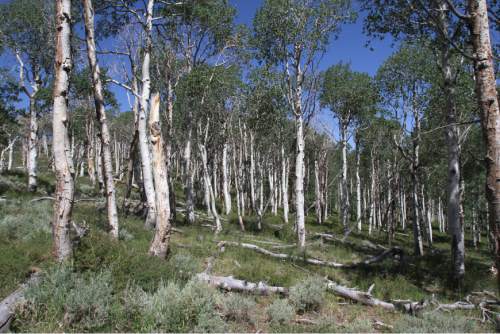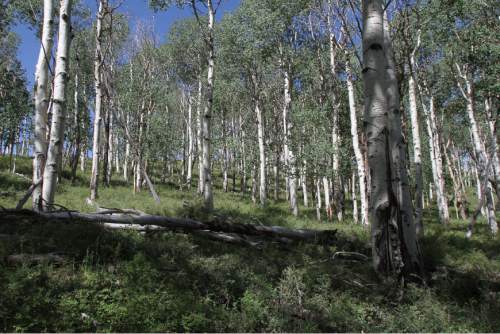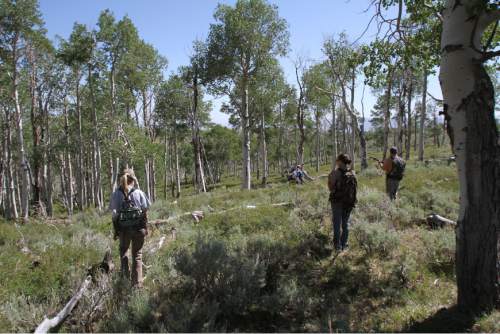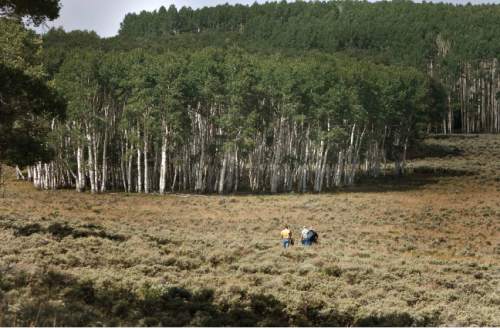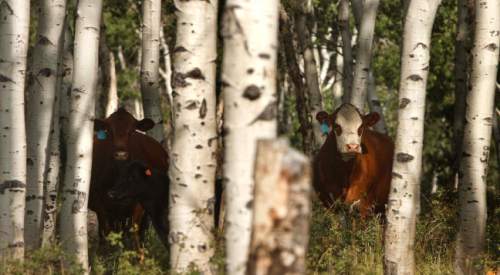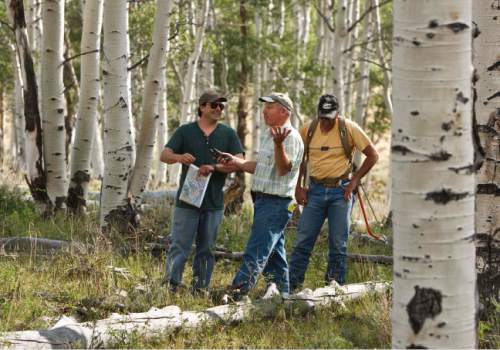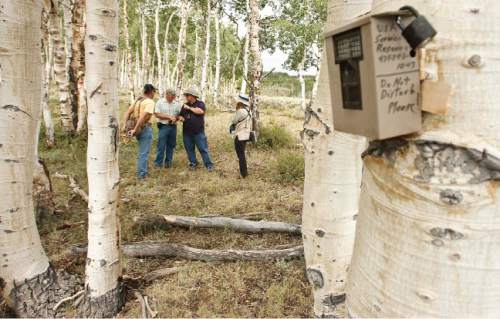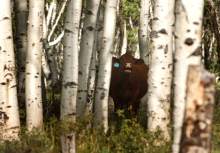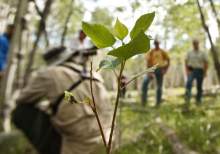This is an archived article that was published on sltrib.com in 2015, and information in the article may be outdated. It is provided only for personal research purposes and may not be reprinted.
For one of Utah's largest aspen communities to rebound and thrive, the U.S. Forest Service says, parts of Monroe Mountain must burn.
Forest Service officials hope to restore aspen in this 175,000-acre patch of Fishlake National Forest through prescribed burning, logging conifers and improved management of the livestock and big game that eat aspen shoots before they can become trees. Flames could be the cheapest and most effective means for clearing out fir-choked stands and triggering the rebirth of aspen, according to Richfield District Ranger Jason Kling.
His plan was finalized Monday after years of analysis and collaborative planning. But it's not sitting well with ranchers who fear it could lead to grazing restrictions, and some environmentalists, who say it promotes logging on thousands of roadless acres, including areas proposed for protection as wilderness.
Still, the Monroe Mountain Aspen Ecosystems Restoration Project has broad support from state and federal agencies, surrounding municipalities and some conservation groups. Officials hope the 10-year program will reverse aspen forests' decline without displacing livestock or the elk and mule deer herds that are prized by sportsmen.
Aspen forests are among the West's signature ecosystems, yet they have been in steep decline thanks to decades of fire suppression and browsing by hungry hooved munchers, both wild and domestic, and more recently from drought and climate change.
"Next to riparian, aspen is the most biodiverse habitat in the West. There is no upland habitat that compares for wildlife, grasses, shrubs, birds. The soft wood is great for a lot of cavity nesters. It drops leaves in the fall [creating mulch that retains water] so snow makes it into the ground underneath and that is a great source for aquifer recharge," said Mary O'Brien of the Grand Canyon Trust, which endorses the project.
Much of Monroe Mountain, the plateau south of Richfield that tops out at 11,226 feet above sea level, was once blanketed in sweeping stands of aspen, but many are either being displaced with subalpine fir and Engelmann spruce or are becoming decrepit because young clonal trees don't get a chance to mature.
—
Fighting with fire • The project envisions using prescribed fire to treat stands where conifers are filling in the spaces around aspen trees, but forest planners don't want to torch stands surrounding the private inholdings. They agreed to log lands up to a mile away from property lines. The problem is that much of this terrain does not have roads, and the 2001 Roadless Areas Conservation Rule is supposed to protect it.
This aspect of the project has drawn a formal objection from WildEarth Guardians and the Western Watersheds Project, which contend that logging is not necessary to accomplish the project's goals or to protect the private land. Nor is it legal, contends Kevin Mueller, WildEarth's Southern Rockies conservation manager.
"This 'shock and awe' style forestry is at the expense of overlooking the biggest root cause of aspen decline," Mueller said. "Monroe Mountain clearly has too many livestock, but the decision fails to deal with this fundamental cause of the aspen problems. We only see a weak wish list of maybe actions. The Forest Service has again put the interests of a few ranchers above the long-term health of public lands."
He believes it would be the largest logging project tapping road-free forest — 9,000 acres — in the lower 48 states since the roadless rule was enacted.
But Kling said the logging plays an important role in protecting sensitive species, such as the boreal toad and northern goshawk.
"It was necessary we do some mechanical thinning in strategic areas so we could be successful with implementation of prescribed burning," Kling said. "We have found a good balance and it's the result of a lot effort by a lot of people."
All told, about 15,000 acres would be logged and 26,000 burned over the next 10 years. Treatments will be conducted in three phases, each beginning with mechanical work followed by prescribed burns. The work starts on the southern third of the plateau and moves to the northern end. The central portion, which contains most of the inholdings, will be treated last.
O'Brien agrees inventoried roadless areas should not be logged, but said accommodations should be made if there are clear restoration goals, as is the case on Monroe. In other words, don't let the perfect get in the way of the good.
"Inholdings within public lands are a major problem because there is an expectation that the agency will alter the ecosystem to protect them," O' Brien said. "I don't see how they could reintroduce fire if they don't do that clearing, the mechanical thinning."
But Mueller suspects the logging will neither prevent fire from reaching the private land nor restore aspen.
"It is doing the property owners a disservice by implying that they will be protected," he said. "People in these inholdings need to prepare for when a fire comes through. They need to be fire-permeable communities."
—
Concerns over cattle • An equally important part of the project is monitoring and research.
A dozen grazing allotments cover the project area, which will include six exclosures — fencing to keep animals out — spread around the mountain. The fencing will keep livestock off 575 areas that will be used to track aspen recovery as part of an intense monitoring effort.
Meanwhile, the Piute County Commission rejects the notion that livestock are to blame for the aspen's decline, arguing the real culprits are fire suppression, reduced timber harvests and elk, which were reintroduced onto the mountain in the 1970s.
Commissioner Darin Bushman said cattle should be treated as part of the solution, not the problem.
"Proper livestock grazing practices can be and are compatible with aspen and can invigorate and stimulate vigorous growth, help fertilize the soils for tree nourishment, stimulate forb [plant] growth such as nitrogen fixing forbs (lupine) that can help fertilize and invigorate aspen stands and aerate the soils with hoof action," Bushman wrote in the commission's formal comments.
He is concerned that ranchers could be asked to shoulder a disproportionate burden by having to reduce stocking levels and keep livestock out of pastures during extended periods following treatment.
Bushman's comments touch on the project's core issue: How to protect aspen shoots once an allotment has been logged or burned.
If cattle and elk graze these nascent trees, not much will be accomplished toward restoring an aspen ecosystem. The Forest Service said it "will seek opportunities" to adjust the timing and intensity of grazing regimes.
"This may include resting treatment areas again from livestock use, temporary reductions in livestock numbers, reducing the length of time that livestock are in certain pastures, and/or adjusting the timeframe of when livestock are in certain pastures," the document states.
Twitter: @brianmaffly
Brian Maffly covers public lands for The Salt Lake Tribune. He can be reached at brianmaffly@gmail.com or 801-257-8713


